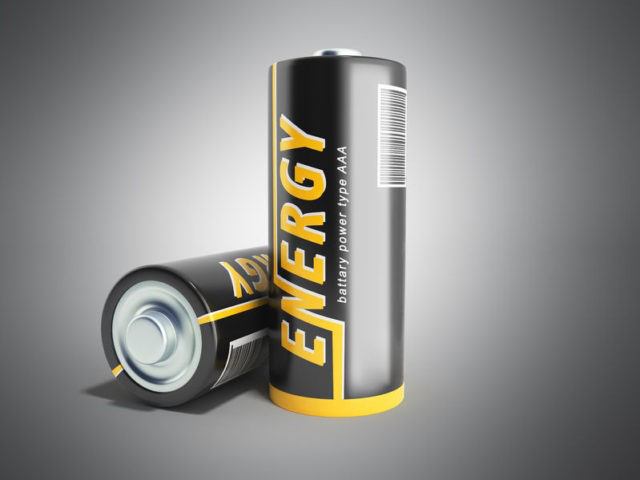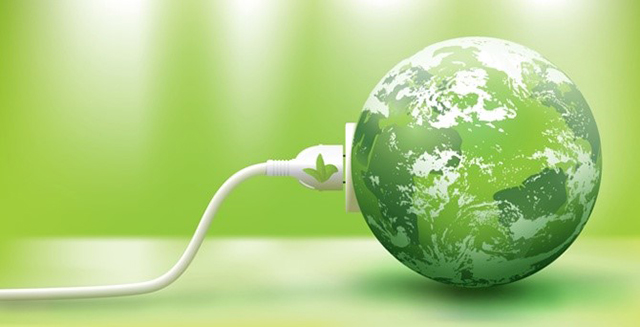
The solar power plant (SPP) of Kalyon Holding slated for the Karapinar district in the central Anatolian province of Konya as part of the first solar Renewable Energy Resource Zone (YEKA) tender will include some 3.5 million solar panels and meet the electricity needs of 2 million people annually.
Some 104,000 panels will be commissioned monthly for approximately 40 megawatts (MW) of energy, an official from the company said.
Kalyon Holding Energy Group Executive Board Member Murtaza Ata said the solar power plant, which will be established in an area of 20 million square meters (215 million square feet) with an investment of $1 billion, will meet the electricity needs of 2 million people annually.
“It is the world's largest power plant built by a single investor on a single parcel. When it is completed, it will be one of the human structures visible from space,” he added.
Ata commented that the National Energy and Mining Policy, prepared during the term of then-Energy Minister Berat Albayrak, paved the way for domestic and renewable energy production.
Kalyon Holding, together with a South Korean Hanwha Q-Cells consortium, won the tender for Turkey's biggest SPP project – the Karapinar Renewable Energy Resources Zone Project – in March 2017 at a cost of $0.0699 per kilowatt-hour. However, Hanwha will not continue with the project, and China Electronics Technology Group Corporation (CETC) has stepped in to construct the facility and to provide an additional two years of technical assistance after the turnkey contract expires.
Source: Daily Sabah

Turkey's clean energy generation sector received around 3.9 billion Turkish liras in incentive payments in August under the Renewable Energy Support Scheme (YEKDEM), according to Turkey's Energy Exchange Istanbul (EXIST) data on Wednesday.
A total of 817 facilities, with an installed capacity of 21,049 megawatts, received financial backing in August and produced about 5.7 million megawatt-hours of electricity.
Turkey, which wants to fully utilize local and renewable energy sources efficiently to support its development, offers feed-in tariffs for renewable energy plants including wind, hydropower, geothermal, biomass and solar through this scheme.
Renewable energy plants under the scheme are granted incentives, the value of which is dependent on the type of renewable energy used.
The scheme, which started in 2011, supports wind and hydropower plants at $0.073 per kilowatt-hour (kWh), geothermal facilities at $0.105 kWh, and solar and biomass plants at $0.133 kWh. These figures can also vary slightly depending on the use of locally-produced equipment in the plants.
US$1 equals 7.49 Turkish liras at 0805 GMT on Wednesday.
Source: Anadolu Agency

Research from Cornwall Insight’s ‘Balancing Mechanism report’ highlights that there are significant changes in the technology type that has been providing balancing actions to the National Grid Electricity System Operator (ESO), with activity from newer asset types seeing the greatest year-on-year increase.
Accepted volumes in the Balancing Mechanism (BM) from identified batteries, gas reciprocating engines and aggregated units across June – August 2020 have all increased, with accepted volumes from batteries rising 149%, gas reciprocating engines increasing 338% and aggregated units increasing 518% year-on-year.
Accepted volumes from wind have also increased by 125%. The only technology to see a decline in activity for these three months was coal. The below charts show the accepted volumes in the BM across all technologies in the June – August 2020 period in comparison to 2019 levels.
Lee Drummee, an analyst at Cornwall Insight, said: “It is no surprise that the BM experienced a notable increase in activity so far this year, in light of the heightened challenges brought by COVID-19. Even after the lockdown restrictions eased total volumes of accepted actions on the BM remained significantly higher in 2020 than in 2019. The total volume of actions across June – August 2020 totalled 9.1TWh, up 40% on the same three months in 2019.
“However, what is most interesting is the technologies that have been providing these balancing actions to the ESO. Newer asset types such as batteries, gas reciprocating engines and aggregated units, which are formed up of multiple technology types, have seen the greatest percentage increase in activity.
“Greater volumes from newer technologies can be attributed to several factors, including the impacts of COVID-19 on power demand and the greater penetration of wind on the system over this period. More importantly, it has been the new BM access routes provided to smaller assets, that have helped bring down barriers to smaller-scale units being able to participate, boosting their role in the BM.
“Also, as more of these types of plant come to market, parties trading these assets are more frequently investing in the ability to access the BM whilst also improving their trading strategies to optimise assets across multiple revenue streams.
Source: Smart Energy International

Google aims to power its data centers and offices 24-7 using solely carbon-free electricity by 2030, its chief executive said, building on its previous goal of matching its energy use with 100% renewable energy.
The “stretch goal,” as CEO Sundar Pichai described it, will force Google to move beyond the tech industry norm of offseting carbon emissions from electricity use and require technological and political breakthroughs to achieve.
“The problem is so immense, many of us need to lead the way and show solutions,” Pichai told Reuters news agency. “We’re one small player in this but we can set an example.”
Wildfires burning a record area in the western United States this month have increased public awareness of climate change, Pichai said, and Google wants to bring further attention through its new goal as well as product features.
Wind, solar and other renewable sources accounted for 61% of Google’s global hourly electricity usage last year. The proportion varied by facility, with carbon-free sources fulfilling 96% of hourly power needs at Google’s wind-swept Oklahoma data center compared with 3% at its gas-reliant Singapore operation.
But Google, which consumes slightly more power annually worldwide than residents and businesses in Delaware, has grown optimistic that it can bridge the gap with batteries to store solar power overnight, emerging sources such as geothermal reservoirs and better management of power needs.
“To plan 24/7 hourly being carbon-free in our data centers and campuses around the world, we see an enormous logistics challenge, which is why we’ve been hard at work modeling the last year how to get there,” Pichai said. “And we feel confident we can get there by 2030.”
Source: Euractiv

Oil demand may have already peaked as it is replaced by fast-growing renewable energy sources such as wind and solar PV, according to oil and gas major BP.
Demand for oil may never fully recover after the coronavirus pandemic and may begin falling in absolute terms for the first time since the industrial revolution, the company concluded in its 2020 Energy Outlook report.
BP sees renewables as being the fastest growing energy source over the next 30 years in all scenarios, especially with wind and solar able to power newly electrified, hard-to-abate sectors such as transport, heating and buildings.
Renewables will meet a greater share of global energy demand, even as energy demand grows, driven by increasing prosperity and living standards in the emerging world, BP believes.
Greater electrification and a rapid growth in renewable energy capacity would also cause a shift in energy consumption away from fossil fuels.
Implementation of decisive policies – such as “significant increases” in carbon prices – can help deliver a lasting reduction in emissions from energy use, the oil and gas major concluded.
Under both BP’s "rapid" and "net zero" scenarios, the report considers that demand for liquid fuels will never fully recover from the fall caused by Covid-19, implying that oil demand peaked in 2019 in both scenarios.
In a business-as-usual scenario, BP sees renewables meeting 20% of global primary energy demand by mid-century – up from 5% today – with emissions in 2050 less than 10% below 2018 levels.
But with the introduction of policies and measures targeting more ambitious carbon emissions reductions this increase could be even greater.
These capacity increases will be underpinned by continuing falls in development costs, with wind about 30% cheaper by mid-century, and solar about 65% cheaper in BP’s ‘rapid’ scenario. In a net zero scenario, wind will be about 35% cheaper by 2050, and solar about 70% cheaper.
Despite the significant growth potential of electricity and renewables in energy demand, BP notes that the world is on an “unsustainable path”.
It added that a series of policy measures, led by a significant increase in carbon prices, will be required to meet climate targets and prevent or mitigate global warming.
These policies may also need to be further reinforced by shifts in societal behaviours and preferences, BP stated.
The oil and gas major warned that delaying these policies, measures and societal shifts may significantly increase the scale of the challenge and lead to significant additional economic costs and disruption.
CEO Bernard Looney said: “Even as the pandemic has dramatically reduced global carbon emissions, the world remains on an unsustainable path.
“However, with decisive policy measures and more low carbon choices from both companies and consumers, the energy transition still can be delivered.”?
Source: Wind Power Monthly

A world where electricity generation is derived from 100% renewable energy is possible if countries adopt a patchwork of existing innovations says the International Renewable Energy Agency.
“Renewable energy is now so competitive that in many geographies it’s the preferred option for electricity generation,” says Francisco Boshell, a renewable energy markets and standards analyst at IRENA.
The transition away from the dependence on fossil fuels and toward the adoption of renewable energy has been partly enabled by an 82% drop in the cost of solar photovoltaics and a 39% decline in the cost of onshore wind power since 2010, says IRENA.
Western countries, such as Iceland which derives 100% of its electricity from renewable energy, the U.K. with 33%, and Sweden which gets a bit over half of its electricity from green power, are most often cited as the success cases for the adoption of alternative energy.
However, a lot of progress has been made elsewhere on the globe. The Central African nation of Rwanda gets 52% of its electricity from renewable energy, while in Latin America, Uruguay and Costa Rica are both inching close to 100% of renewable electricity, underpinned by a mix of wind, solar, large hydropower and, especially in the latter case, biomass and geothermal energy.
Overall, 8 countries including Cape Verde, Austria, and Tuvalu are aiming to get all their electricity from renewable energy over approximately the next two decades, while Denmark is the only country with a target of 100% renewables for all sectors.
Still, renewable energy sources like solar and wind power can be interrupted when the sun does not shine or there is a lull in the wind. More importantly, engineers can’t ramp up the output of green energy to meet spikes in demand unless they can store energy or shift demand loads.
“There is still one big challenge and that’s the integration of variable renewable power systems,” Boshell told Karma. “That requires a lot of innovation to unlock what is called flexibility.”
IRENA has identified about 30 existing technological innovations and policy prescriptions that may enable the global transition away from fossil fuels, and the reduction of carbon emissions that are linked to global warming and more extreme weather patterns such as hurricanes and droughts.
The major innovation that IRENA points to is utility-grade batteries that enable electricity grid operators to store power and deploy it during times of high demand. Battery storage costs have fallen by 85% over the last decade.
The agency also advocates for the use of artificial intelligence algorithms to better forecast demand and generation as well as optimize the functions of large transmission grids in real time.
Meanwhile, blockchain technology is expected to facilitate transactions and help energy consumers pay and receive payments for giving power back to the grid from the batteries on their electrical vehicles or from solar panels on their rooftops — so-called “demand-side flexibility.”
The last innovation would require policymakers to design a system that provides financial incentives for consumers to give back power to the grid, say experts.
“All of these actions will have to be done with automated smart contracts and blockchain would help with that,” Boshell told Karma.
Some marketplayers say the price tag for all the innovation may be steep, especially for developing countries. But Boshell says that efficiency drives — like replacing legacy infrastructure such as backup power gas plants with batteries — will incentivize low-cost operators to come onto the market and keep a lid on the bill consumers have to pay.
“The whole idea is that we don’t need the system to be morecostly,” Boshell said. “We just need the right incentives to direct the revenue streams to the right actors.”
Source: Karma Impact
Energy Technology Perspectives 2020
Energy Technology Perspectives 2020 is a major new IEA publication focused on the technology needs and opportunities for reaching international climate and sustainable energy goals. This flagship report offers vital analysis and advice on the clean energy technologies the world needs to meet net-zero emissions objectives.
Please click here to read the full report.

